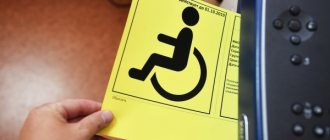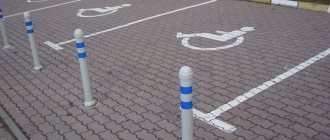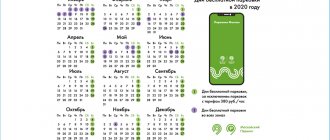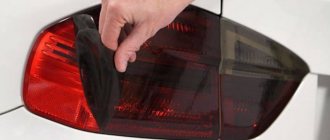It’s worth starting with the fact that the “Disabled Person” identification badge provides its owner with a number of benefits. The procedure for issuing the identification badge “Disabled” for individual use (as amended on September 4, 2021) establishes that this sticker can be used by disabled people of groups 1, 2 and 3, parents whose children are disabled and people who transport disabled people.
Purchasing such a plate before 2021 was not difficult, but from September 4, 2021, the procedure for obtaining it has become more stringent and now to obtain it you must visit the bureau involved in medical and social examination. This organization issues documents indicating disability.
From 2021, the plate must indicate the disability group, region code, details of its owner and the duration of the disability. And the most convenient thing, according to citizens, is that this sign can be used not only in a specific car, but, for example, in a taxi that is used by a person with disabilities. Simply place this sign under the car windows on the windshield.
Car signs that do not include disabled people
According to the Traffic Rules, some prohibitory signs do not apply to cars driven by disabled people of groups 1, 2 and 3.
“Parking is prohibited” (3.28), “Traffic is prohibited” (3.2), “Parking is prohibited on even days of the month” (3.30), “Parking is prohibited on odd days of the month” (3.29), “Motor vehicle traffic is prohibited.”
From 2021, these signs do not apply to cars that have a “Disabled” sign installed. An additional requirement has been established - presentation of a disabled person's certificate at the request of a traffic police officer.
Sign 3.28. Does not apply to vehicles driven by disabled people
Signs for disabled people
In addition to the above benefits prescribed in the traffic rules, there are two special signs that directly relate to disabled persons, containing the following information:
8.17 "Disabled"
Notifies that the effect of sign 6.4 relates only to motorized wheelchairs and vehicles with the “Disabled Person” identification badge attached.
Table "Disabled"
8.18 “Except for disabled people”
Means that the validity of a certain sign does not apply to motorized wheelchairs and vehicles with the “Disabled Person” badge installed.
Table "Except for disabled people"
Disabled parking
The first indicated plate is used only with sign 6.4. This combination indicates a parking space or parking for persons with disabilities. The provided place can be used by any person who has the status of a disabled person, regardless of the assigned category.
Road sign indicating parking for persons with disabilities
The combination of sign and table is always accompanied by corresponding road markings. The second plate is used in more cases with signs prohibiting certain actions while driving.
Effect of road signs for disabled people according to traffic rules
The “Parking for the Disabled” sign (6.4) is installed in the following places:
- Near cultural institutions;
- close to shops and public places;
- near residential buildings.
Sign 6.4. with sign 8.17
Another penalty was established by Federal Law 143-FZ “On Amendments to the Code of the Russian Federation on Administrative Offenses and Article 21 of the Federal Law “On Road Safety” On June 19, 2015, a fine of 5,000 rubles is provided for the illegal use of the “Disabled” identification badge . The above changes are commented on the website of the Ministry of Internal Affairs: “These decisions are designed to increase the social protection of persons with disabilities and reduce the number of offenses in connection with the use of the “Disabled” identification mark.
Important!
Despite all the changes and improvements in the quality of life of people with disabilities, there are a huge number of pitfalls when using these benefits. Relatives and friends of disabled people have the “Disabled Person” identification mark on their vehicles, as they often transport them. They are afraid of what will happen if there is a sign on the car, but the disabled person is not in the car? The legislator explains this situation as follows: on a regular road, the “Disabled” sign does not have any advantages, therefore, the driver does not enjoy any benefits and no violations occur.
The State Duma is of the opinion that the amendments to the traffic rules left many ambiguities and require further refinement.
In Moscow and the Moscow region, slightly different parking rules apply for people with disabilities. For such persons and legal representatives of a disabled child, a special permit is provided, the presence of which gives the right to free 24-hour parking in places for the disabled. Such permission can be obtained from the MFC.
Important!
The advantage is that it is issued not per person, but per vehicle. The car number is entered into a special register and the convenience is that even if the car is transporting a disabled person, and he is away to see a doctor or is undergoing treatment, then such a vehicle can be parked for the disabled.
However, this situation again has its drawbacks. This difference between Moscow and regional legislation does not play into the hands of visiting citizens. A disabled driver can easily get a ticket or not find their car in a disabled parking lot. After all, she will simply be taken to the impound lot for violating traffic rules, since the license plates are not in the Moscow registers of cars belonging to disabled people.
There are additional information signs:
- A sign depicting a person in a wheelchair on a white background (the sign applies only to disabled people) (8.17);
- a sign with the image of a person in a wheelchair crossed out with a red line (the sign is valid for all vehicles except those owned by disabled people) (8.18).
Sign 6.4. with sign 8.17
Earlier in our article there was information about documents confirming disability. Such documents include the relevant certificate and a special identification mark. No other documents are valid for traffic police officers.
On February 6, 2021, new amendments to the Traffic Rules came into force, which established the mandatory presentation of such documents confirming limited physical capabilities.
In 2021, there were changes in legislation that increased the amount of the fine for illegally installing a “Disabled Person” identification sign and for illegally driving a vehicle with a “Disabled Person” sign, the amount of which reached 5,000 rubles.
To date, frequent complaints have been recorded from persons with disabilities due to the fact that they are being fined without reason. This is a completely understandable situation, because cameras cannot identify whether a car has a “Disabled” sign or not. In such cases, lawyers advise applying with supporting documents to the contact details specified in the letter about the fine. This way you can appeal the fine.
What to do if a fine is imposed on a disabled person?
From time to time in practice I come across the following situation. The disabled person stopped the car within the coverage area of sign 3.28, and then received a fine by mail, recorded by an automatic camera. This is quite possible, because cameras are not able to record the presence of an identification mark for a disabled person.
However, in this case there is no need to despair; the fine will be easy to appeal. Just contact us using the contact details provided in the letter. As proof of your own innocence, take a document confirming the disability of the driver or his passenger.
Read also: Cost of Nissan Almera from an official dealer
Cancellation of an illegal fine should not be difficult, but you will have to spend time on this procedure.
In conclusion, I would like to note that several of the benefits listed in the article are not provided to disabled people because of a good life. Therefore, I recommend that other drivers not occupy special seats for disabled people, especially since the fine for this is quite significant (5,000 rubles).
Most recently, the Moscow authorities supported the proposal to evacuate vehicles with a “disabled person” sign, which was placed illegally on the windshield.
In particular, according to the head of the capital’s transport department, Maxim Liksutov, such cars can be evacuated.
Russia may soon introduce serious punishment for those who illegally use the privileges of citizens with limited mobility. The fine for motorists who park their vehicles in spaces for people with disabilities ranges from 3,000 to 5,000 rubles.
Currently in Moscow, 10% of parking spaces are allocated for people with disabilities. Recently, Moscow Deputy Mayor for Social Development Leonid Pechatnikov proposed to evacuate cars illegally parked in parking lots for the disabled.
The issue of punishment for illegal placement of a “disabled person” sticker is also being resolved.
Deputy Mayor of Moscow for Social Development Leonid Pechatnikov made a proposal to evacuate cars parked illegally in parking lots for the disabled. Lawyers identify several difficulties in this situation:
- Check the validity of the sticker when the driver is present in the car. Then - yes, every disabled person has a supporting document with him. This is a certificate, after looking at which the inspector can make sure that the sticker is legal.
- In the case of parking a “disabled” car, it is almost impossible to prove legality or illegality. Imagine: a car with a sticker is parked in a place designated for disabled people. There is no driver. Don't wait for him for several hours. And what, then they will give him a fine, simply because of suspicions that he theoretically may not be disabled? But this is nonsense. People will appeal the fines endlessly. As for creating a unified base, this is also not easy. A person who has a disability needs to have it confirmed every few years. And if it was deregistered (this happens), how quickly will it be removed from the database? Therefore, now the proposal rather raises a lot of questions.”
It should be noted that citizens who brazenly pretend to be disabled people take advantage of disabled people.
The effect of the indicated signs that are violated by “pseudo-disabled people”: 3.2 “Movement is prohibited”, 3.3 “Movement of mechanical vehicles”, 3.28-3.30 “Parking is prohibited”, 3.29 “Parking is prohibited on odd-numbered days”, 3.30 “Parking is prohibited on even-numbered days” does not apply - for vehicles driven by disabled people of groups I and II or transporting such disabled people.
Many disabled people drive under these signs without fear. Especially sign 3.2 “No movement”, and others mentioned above.
So, drivers with disabilities must install a “Disabled” identification sign on their cars, optionally on the front or rear window. This applies primarily to disabled people of groups I and II or those transporting them.
Now let’s look at the signs listed above, what they mean and what they free you from.
The traffic rules of the Russian Federation for disabled drivers of groups I and II or those transporting them do not apply road signs “Traffic is prohibited”, “Motor vehicles are prohibited”, “Parking is prohibited”, “Parking is prohibited on odd days of the month” and “Parking is prohibited” on even days of the month." There are also additional information signs - “Disabled Persons”. Please note: in the description of sign 8.17 only vehicles with the identification sign “disabled” are indicated; there is not a word about the disabled themselves. This means that violation of the requirements of this sign consists precisely in parking a vehicle without an identification sign. The Basic Provisions for the admission of vehicles to operation and the responsibilities of officials to ensure road safety state that such an identification mark is installed at will, “Except for persons with disabilities” and the corresponding markings. The “Disabled Persons” sign under the “Parking Place” sign says that its effect applies only to motorized wheelchairs and cars with the “Disabled Person” identification sign. The “Except for Disabled Persons” sign indicates that any sign does not apply to motorized wheelchairs and cars driven by people with disabilities. Only driver candidates should know the following: examinations for citizens with disabilities who, for medical reasons, are allowed to drive vehicles are carried out in special cars with additional structures. They are provided by their educational institution. Currently, the Russian State Traffic Inspectorate is preparing a number of regulations amending the Federal Law “On Road Safety”, the Rules for passing qualifying exams and issuing driver’s licenses in order to optimize the procedure for allowing disabled people to drive a car, as well as significantly simplify the procedures for them to obtain services in the traffic police.
Read also: Who produces Rolf oil
The following cannot be applied to disabled people:
- deprivation of the right to drive (except for cases of driving while intoxicated, refusal to undergo an examination or leaving the scene of an accident);
- administrative arrest for disabled people of groups I and II.
All other requirements of both traffic rules and the Code of Administrative Offenses apply to disabled people in full.
Do people with disabilities have the right to free transportation?
Federal Law dated August 22, 2004 No. 122-FZ from the Law dated November 24, 1995 No. 181-FZ “On Social Protection of Disabled Persons in the Russian Federation” excluded the provision granting disabled people the right to receive specialized vehicles free of charge.
As we see, laws prescribe significant benefits for people with disabilities, as well as for persons transporting people with disabilities.
Traffic police officers have only one opportunity to determine whether the owner of the car is a person who has the ability to park his car under prohibitory signs in the absence of the driver, this is sign 8.17 in front and behind the car.
Thus, if the driver of the vehicle is a disabled person of group I or II, but has not installed sign 8.17, then the traffic police officer issues a fine and sends the car to the impound lot justifiably.
What does the law tell us about installing these signs on a car?
We open the “Basic provisions for the admission of vehicles to operation and the responsibilities of officials to ensure road safety”, approved by Government Decree of October 23, 1993 No. 1090 ON ROAD TRAFFIC RULES, and read the following in paragraph 8:
At the driver's request, identification marks can be installed:
“Doctor” - in the form of a blue square (side 140 mm) with an inscribed white circle (diameter 125 mm), on which a red cross is applied (height 90 mm, stroke width 25 mm), - in front and behind cars driven by driver-doctors ;
“Disabled person” - in the form of a yellow square with a side of 150 mm and an image of the symbol of road sign 8.17 in black - in front and behind motor vehicles driven by disabled people of groups I and II, transporting such disabled people or disabled children.
As you know, “Disabled” stickers are sold freely in all automobile stores. What limits drivers from deceiving the inspector by installing such a sign on their car?
The answer is simple - nothing.
The list of documents that the driver must present to the traffic police inspector is stated in 2.1.1 of the traffic rules, but there are no documents confirming the presence of a disability there. This obvious “hole” in the law makes it possible to obtain obvious advantages over other drivers.
Many drivers refer to the fact that this sign can be installed not only by disabled people, but also by persons transporting disabled people. However, this also most often will not work if the traffic police officer suspects fraud on the part of the driver. If you are not currently transporting a person with a group I or II disability and are not expecting his arrival any minute, you will most likely be issued a fine. If there are any objections on your part, the court will sort it out.
Thus, the presence of an obvious “hole” in the law does not always work in practice. A decent driver will never take advantage of the misfortune of a particular category of citizens. The attitude towards violators of this kind both from the traffic police officers, and from the judicial authorities, and from other road users will always be unambiguous.
Author: Yulia Sirotkina, publication date: 04/30/2015 Reproduction is prohibited. Copyright is protected by law.
For several years now, cars have ceased to be considered a technical means of transportation. This was announced by the so-called law on the monetization of benefits. But despite this, people with physical disabilities have not stopped being motorists. Russian disabled people themselves try to provide themselves with a vehicle, be it a domestic car or a foreign car.
Read also: How to charge parallel connected 18650 batteries
The current traffic rules in Russia provide preferential conditions for traveling on roads for disabled motorists.
What penalties do not apply to disabled people?
There is a list of punishments that cannot be applied to a disabled person:
- Administrative arrest for disabled people of groups 1, 2 and 3;
- deprivation of the right to drive (with the exception of cases of driving a vehicle while intoxicated and refusal to undergo examination).
The remaining types of requirements of the Code of Administrative Offenses and Traffic Regulations fully apply to persons with disabilities.
Marking
In addition to special road signs for disabled people, there are also road markings “Disabled People”. It involves painting a similar “Disabled” sign on concrete or asphalt. The following markup applies to:
- Roadside;
- roadway;
- on tram tracks;
- pedestrian paths.
Markings for disabled people
Road markings and signs can be either together or separately from each other. If there is no sign, but there are markings, or vice versa, this does not give drivers the right to neglect the first or second. Separately, the sign and markings carry absolutely the same significance as together.
I would like to note the features of parking spaces for the disabled, because they also have differences. A regular parking lot is 2.5 meters wide, but a parking lot for disabled people is 3.6 meters wide. This is necessary so that a person with disabilities can not only open the door and get out, but also roll out the stroller. The parking area for disabled people takes up about 10% of the total parking area. And if we talk about institutions specializing in musculoskeletal systems, then the area increases to 20%.
Another feature of parking for disabled people is mandatory road markings. In this case, if there are markings, but there is no sign, then the driver can ignore it with complete confidence.
The “Disabled Person” sign is installed on vehicles driven by disabled drivers of groups I and II, as well as transporting such disabled people and disabled children.
Traffic regulations of the Russian Federation define relaxations for drivers with disabilities. They can park in special parking lots, they are not subject to the signs “Traffic is prohibited”, “Motor vehicle traffic is prohibited”, “Parking is prohibited”, “Parking is prohibited on odd days of the month”, “Parking is prohibited on even days of the month”.
All relaxations specified in the rules concern essentially the accessible environment. Disabled people are allocated parking spaces closer to institutions and are allowed to drive up and stop where others are not allowed - all to make it easier for the person in the car to get to their destination.
Previously, according to the rules, the installation of a special sign was mandatory only for parking under the “Parking Place” sign with a “Disabled Persons” sign. Now you can only drive under a “No Traffic” sign or stand under a “No Parking” sign if you have a sign on your car.
For those who cannot document the legality of installing the “Disabled” sign, penalties have been in effect since July 19 last year. The fine for violation is 5,000 rubles.
“The decisions taken will improve the social protection of persons with disabilities and eliminate cases of unlawful use of “Disabled” identification marks, as well as eliminate the possibility of violation of relevant prohibiting road signs by persons who do not have the right to do so,” says the official press release on the website Traffic police
However, the question remains unclear: how can this norm be implemented? It will work 100% only for a disabled driver who can carry the certificate with him. But those who transport passengers with disabilities may have problems.
For example, a person comes to the door of the clinic to pick up his relative. And he stops under the “No Parking” sign. Is he violating? What document must he present to confirm his passenger status? Will a copy of the certificate be enough or does it need to be notarized?
There is another difficult situation. It is no secret that people with disabilities, especially young people, are often forced to undergo regular re-examination - disability is given for a year or two. When sending documents to ITU, the original certificate is removed and attached to the case. In this case, they can call you to the commission either in a week or in a month. And it turns out that during this time you need to peel off the “Disabled” sign.
The absolutely draconian amount of the fine is also surprising. Obviously, the law needs a separate provision determining the amount of the fine in the absence of a document. Otherwise, those who forgot the certificate will pay 5,000 rubles, and those who went on the road, for example, without mandatory insurance for everyone, will fork out only 800. It turns out unfair. Why not introduce a rule according to which a person can challenge a fine in the traffic police and, by presenting a certificate of disability, receive a receipt for a smaller amount? For example, a symbolic 100 rubles. For forgetfulness.
But these little things are not specified in government decree No. 23 of January 21, 2016. It turns out that for drivers with disabilities and those transporting disabled passengers especially, the rules have again become stricter.
For those who have disabled people in the family, it is better to acquire temporary signs that can be easily removed and installed. But in many families there is one car, but several drivers. Imagine that a wheelchair user will have to do this procedure every day before and after the trip.
It is clear that the law is trying to fight arrogant and rude drivers who stick signs on their SUVs in the hope of “getting” a free parking space. But because of the ill-conceived norms and regulations, it is, as always, the most vulnerable who suffer.











